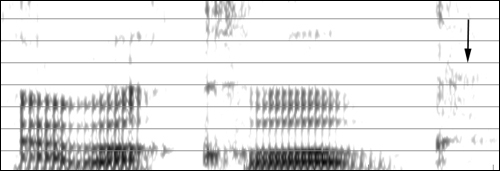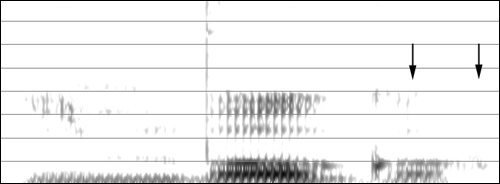Phonology: case studies
By Scott Myers and Megan Crowhurst
Department of Linguistics at the University of Texas
Final devoicing
Listen to the following words:
abakobwa [aβakǒ:βgḁ] "women"
imbogo [imbogóʰ] "water buffalo"
The last vowel is entirely or partially voiceless. This is evident in spectrograms of these utterances. The regularly spaced vertical striations that mark the voicing pulses in a voiced vowel are absent at the end of these utterances.
Fig. 1. Spectrogram of abakobwa [aβakǒ:βgḁ] "women".
The arrow indicates the final voiceless vowel.

Fig. 2. Spectrogram of imbogo [imbogóʰ] "water buffalo". The first
arrow indicates the voiced portion of the final vowel, and the second
indicates the final voiceless portion.

The final segment in an utterance is always a vowel in Kinyarwanda, and a final portion of that vowel is almost always voiceless. The extent of the voicelessness ranges from a small part of the vowel (transcribed with a final superscript - ʰ) to the whole of it (transcribed with a voiceless diacritic under the vowel symbol, e.g. ḁ). The voiceless portion is very quiet, and sometimes close to inaudible.
Such voiceless or partially voiceless vowels occur only at the end of an utterance. A vowel that is at the end of a word but not at the end of an utterance is voiced. In the following examples, the words abakobwa "women" and imbogo "water buffalo", which were heard above in utterance-final position and with partially voiceless final vowels, are heard here in nonfinal position in the utterance and with fully voiced final vowels:
abakobwa benshi [aβakǒ:βgaβê:nʃi̥] "many women"
imbogo zicaye [imboɣózî:tʃaje̥] "sitting water buffaloes"
This pattern of utterance-final partial devoicing of segments is common in the world's languages, including English (Haggard 1978), French (Smith 2003), and Finnish (Ogden 2001). It reflects the fact that during pause the vocal folds are wide apart to facilitate breathing, and speakers begin to move to this posture as the pause approaches. The result is a gradual breakdown in voicing, sometimes spread out over more than one syllable. For further discussion, see Myers (2005) and Myers and Hansen (2007). This is an instance of coarticulation, the ubiquitous overlap of articulatory gestures from different segments.
This is not a phonological pattern. It would not do justice to the facts to say that there is a category of voiceless vowels that occur only at the end of an utterance. The devoicing usually doesn't affect the whole utterance-final vowel, but just that part of it that is closest to the end. The shorter the duration of the final vowel, the more of it is voiceless, so that, for example, more of the final vowel is devoiced in faster speech than in slower speech. These are not generalizations about sound categories, but about how the sound categories are realized in this particular position. This is a phonetic pattern, not a phonological one.
References
Haggard, M. (1978). The devoicing of voiced fricatives.
Journal of Phonetics 6. 95-102.
Myers, S. (2005). Vowel duration and neutralization of vowel length
contrasts in Kinyarwanda. Journal of Phonetics 33. 427-446.
Myers, S. and B. B. Hansen (2007). The origin of vowel length
neutralization in final position: Evidence from Finnish speakers.
Natural Language and Linguistic Theory 25. 157-193.
Ogden, R. (2001). Turn transition, creak and glottal stop in Finnish
talk-in-interaction. Journal of the International Phonetic Association
31. 139-152.
Smith, C. (2003). Vowel devoicing in Contemporary French. French
Language Studies 13. 177-194.